Community Health Collaborative Toolkit
Welcome to the Community Health Collaborative (CHC) Toolkit!
This toolkit is a free resource that aims to assist you as you work towards building and sustaining a Community Health Collaborative. At It’s Time Texas, we consider a CHC to be a group of community members, leaders, or organizations working together to address the health needs in their community. We believe that CHCs play a key role in creating a culture that values and uplifts health for all members of a community and has the ability to make lasting change.
In this toolkit you will find a wide variety of resources, tools, best practices, and case studies that will guide your Community Health Collaborative at every stage of our CHC Framework.
Our Community Capacity Building team is here to support you and your collaborative through this process. Along with this toolkit, we provide one-on-one consulting support and host Community Lab, a peer-to-peer, web-based forum providing free, interactive training and support to Community Health Collaboratives throughout Texas.
Community Health Collaborative Timeline
We have created this timeline to outline the key characteristics of collaboratives in different stages of development. While every CHC is unique in their own way, we have found there are several key characteristics that put CHCs in the Initiating, Emerging, or Established stage.
Keep in mind that these stages are a guideline based on our research and the experiences of the collaboratives we have worked with. Many factors can impact the amount of time it takes a collaborative to transition from one stage to the next:
- A leader who inspires trust, instills confidence, is inclusive, and adept at managing conflict
- Funding and/or staffing provided by the initiating organization
- Membership with previous experience collaborating
- Clear definition of roles and responsibilities
- Frequent communication, flexibility, and adaptability
Collaboratives lacking some of these characteristics can still be successful; however, transition from one stage to another may take a little more time.
Interested in learning the phase your CHC is currently in?
Complete the quiz below to learn more.
Collaboratives in this stage:
Initiating
- Have an incomplete or developing governance structure
- Respond to perceived needs rather than needs identified through research
are focused on quick wins - Rely on in-kind donations or financial support from the initiating organization
- Are working to increase community buy-in
- Are typically in their first 1-3 years of development
Emerging
- Have a governance structure in place, but continue to identify key stakeholders
- Have needs that overwhelm capacity, but focus has transitioned to community priorities
- Are able to leverage community assets
- Have identified additional sources of funding and began developing those relationships
- Have an established evidence base for priorities
- Typically transition to the next stage after 2-5 years
Established
- Have established yet flexible policies
- Maintain partnerships with external funders
- Are able to adjust programming to fit the needs of a changing community, enabling them to stay relevant and avoid stagnation
- Recognized within the community
- Engage in a process of renewal every 2-5 years
Community Health Collaborative Framework
Along with our Timeline, we have created the Community Health Collaborative Framework. This Framework is designed to provide a simple ‘at-a-glance’ overview of the process your CHC can expect to implement when getting started or growing stronger. As with anything that is cyclical in nature, you have to start somewhere. But once you begin, each focus area informs the next in one continuous loop, as demonstrated in the model below.
As you explore each focus area you will also find links to helpful tools, resources, and case studies. Some of these tools and resources apply more broadly to multiple focus areas or have been widely requested
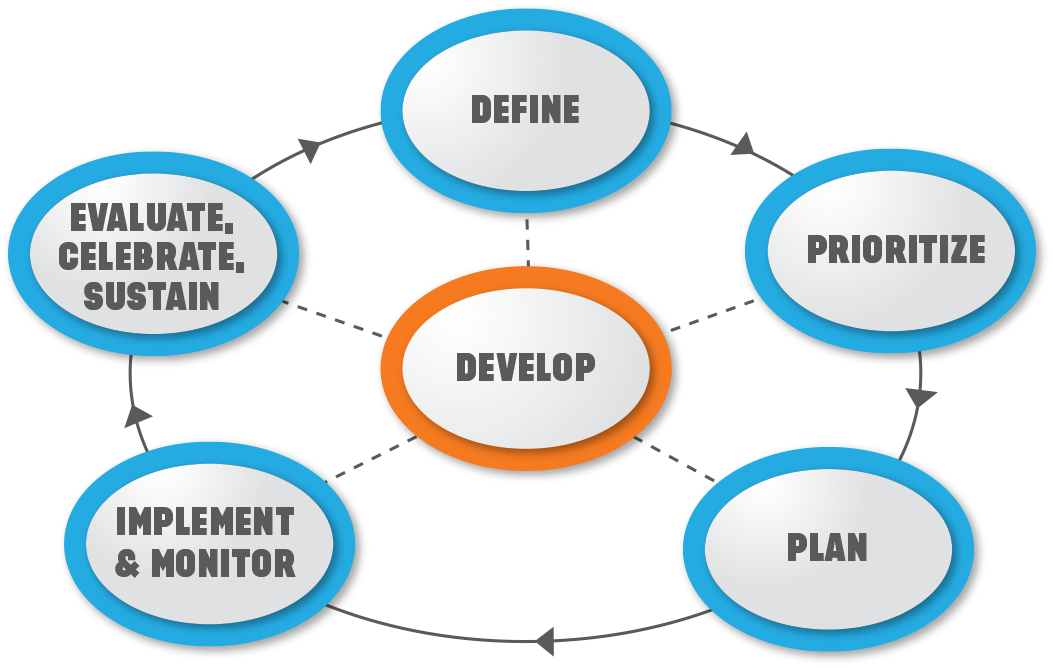
Use the buttons below to read a brief description of each focus area in the Framework.
More detailed information, as well as the corresponding timeline and tools and resources, can be found by clicking the “Learn More” button for each focus area.

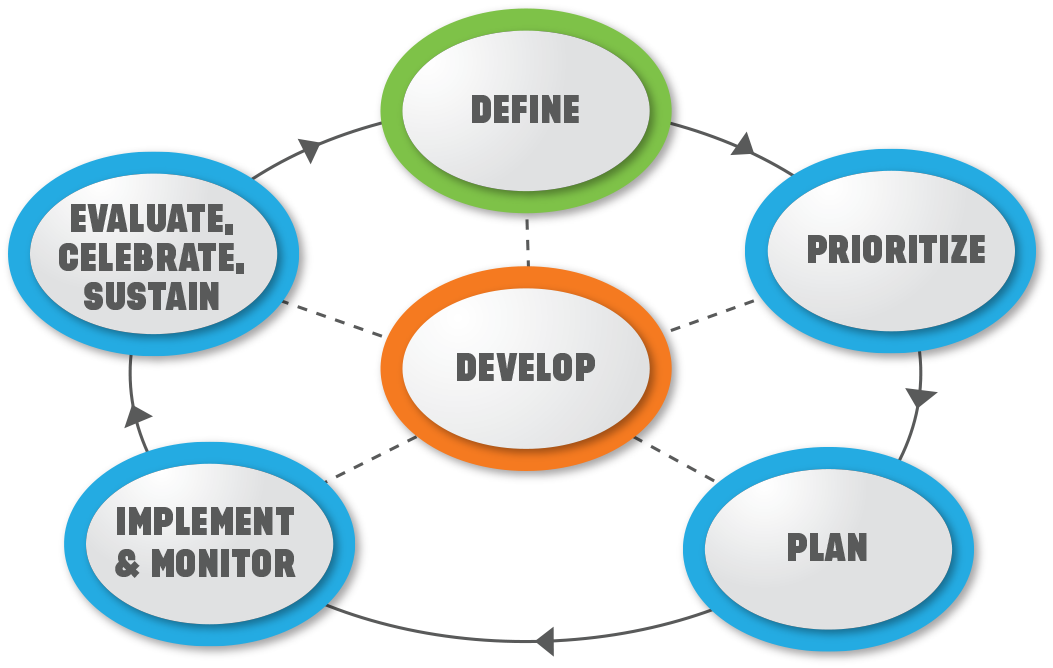
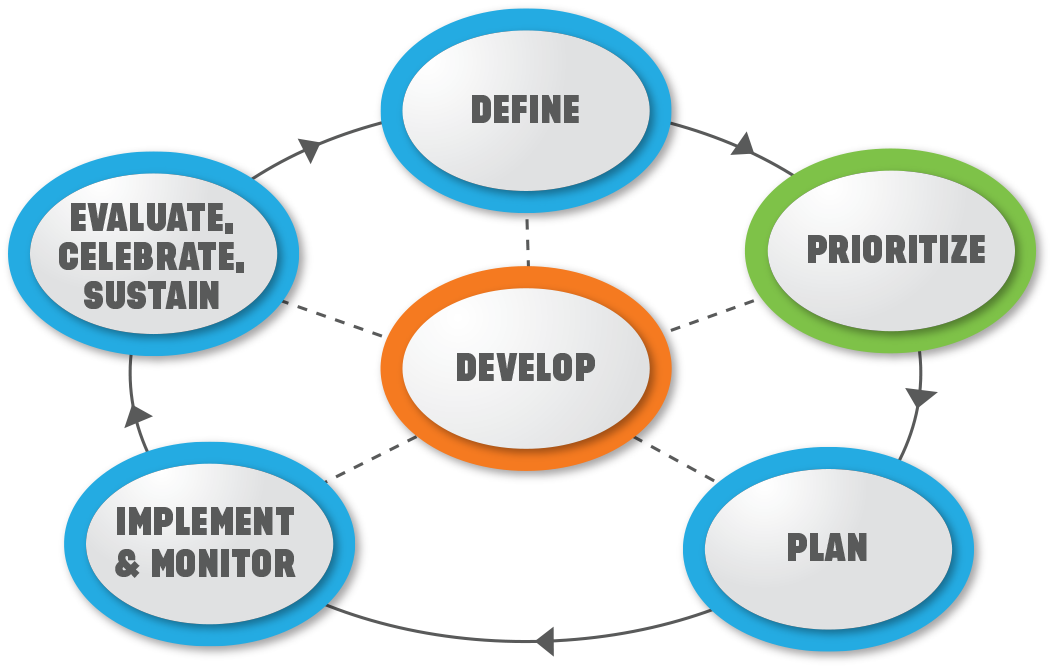

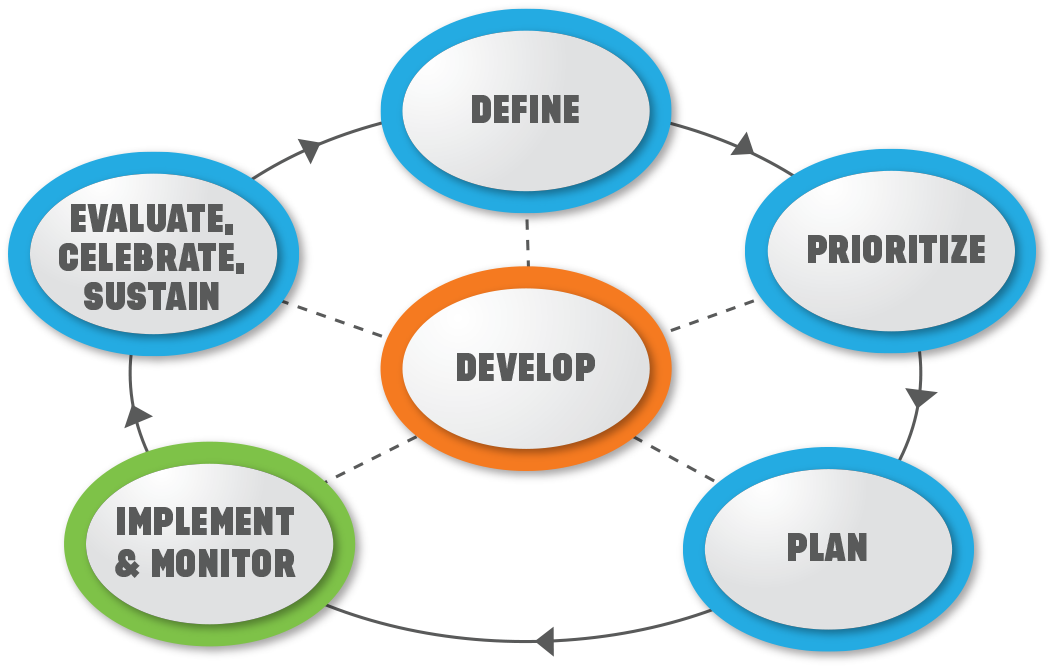
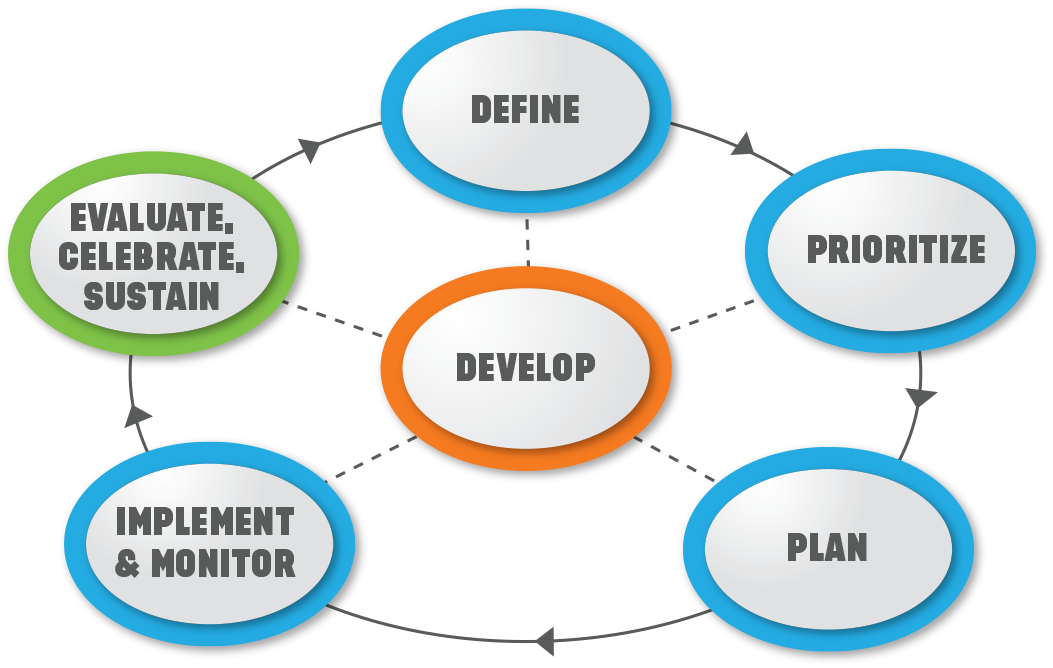
Focus Area: Develop
Before any work is started, we have to assemble a team and create a working process. We included this topic in the center of our framework because it lays the foundation for your work and guides your collaborative as you continue to grow.
There are three things you should consider for this topic:

Key Steps & Considerations
When assembling your team think about what resources you need and who should be at the table. While funding is important, you will also want to consider credibility, expertise, relationships, facilities, and volunteer resources. It is also important to engage with and include community members who are impacted by health disparities. This brings different perspectives to the group.
Never underestimate the importance of passion!
Now that you have your team together it’s time to unite around a shared vision to ground your collaborative’s work. Invite stakeholders to share what their vision of a healthy community is and identify the common themes. The common themes that emerge from this conversation will help to create the backbone of your collaborative’s vision and mission statement
Tools & Resources
With your team members identified and a vision statement created, the next step is to decide how you would like your CHC to be structured. This structure serves as the operating manual for your CHC and shows members how things are organized and the rules that are in place.
Some things an organizational structure will include is:
- How members are accepted
- How leadership is chosen and how long a leadership position is held
- How decisions as a group are made
While there are a variety of ways to structure your CHC it is important to ensure that all participants have power in how to shape your CHC and the work that will be done.
Focus Area: Define
Understanding what you mean by ‘community’ and determining who is included in your target audience are important steps when trying to build a healthy community. Take time to get to know those who represent your community, what needs are present, and what resources are already available to the public.
The first step in having a positive impact on your community is determining what you mean by ‘community’ and seeking to understand it from a variety of perspectives.
Some important things to consider when defining “community”
- Is the focus on a geographical community such as a neighborhood, city, or county?
- Is the focus on a community interest like a workplace, church, or disease-affected population?
Make sure to you learn about the community from a variety of perspectives.
A good starting point is to reach out to:
- Elected officials
- Clergy
- School staff/faculty
- Community activists and/or advocacy groups
- Nonprofit groups or social service providers
- Community members with lived experience
- Community leaders (both official and unofficial)
- Employers, health professionals, and others.
Tools & Resources
In order to have the greatest impact, a deep understanding what your community’s needs are is necessary. Community members have a great deal of insight into their community and are able to identify needs that may be missed by outside observers. Engaging you community members also increases community buy-in, making it more likely that community members will support program implementation efforts
When asking for input from your community, it is important to consider what resource will be needed to fully engage community members. Some things to consider:
- A central meeting location with various transportation routes/ options
- Childcare for parents with young children
- Compensation for the time and effort from the community
- A meeting time that is not during working hours
Once you have identified what the needs are in your community, it is time to determine what the assets and barriers are to address these needs.
Assets can come in the form of a person, a community service, a local employer, or a place. Anything within the community that can be leveraged to improve health outcomes is an asset. Similarly, anything in the community that stands as an obstacle to improving health outcomes is a barrier. Identifying barriers helps us understand why the needs identified by the community exist
Tools & Resources
Identifying Assets
Identifying Barriers
Collaboratives in the Define stage:
Initiating
- Identify and define community of interest
- Begin community needs assessment
- Transition from focus on perceived needs to focus on identified needs
Emerging
- Maintain focus on community of interest
- Engage community members in the assessment process
- Leverage community assets
Established
- Recognize demographic changes in the community and seek to understand the impact of these changes on organizational priorities
- Renew community needs assessment regularly
Key Steps & Considerations
The first step in having a positive impact on your community is determining what you mean by ‘community’ and seeking to understand it from a variety of perspectives.
Some important things to consider when defining “community”
- Is the focus on a geographical community such as a neighborhood, city, or county?
- Is the focus on a community interest like a workplace, church, or disease-affected population?
Make sure to you learn about the community from a variety of perspectives.
A good starting point is to reach out to:
- Elected officials
- Clergy
- School staff/faculty
- Community activists and/or advocacy groups
- Nonprofit groups or social service providers
- Community members with lived experience
- Community leaders (both official and unofficial)
- Employers, health professionals, and others.
Tools & Resources
In order to have the greatest impact, a deep understanding what your community’s needs are is necessary. Community members have a great deal of insight into their community and are able to identify needs that may be missed by outside observers. Engaging you community members also increases community buy-in, making it more likely that community members will support program implementation efforts
When asking for input from your community, it is important to consider what resource will be needed to fully engage community members. Some things to consider:
- A central meeting location with various transportation routes/ options
- Childcare for parents with young children
- Compensation for the time and effort from the community
- A meeting time that is not during working hours
Once you have identified what the needs are in your community, it is time to determine what the assets and barriers are to address these needs.
Assets can come in the form of a person, a community service, a local employer, or a place. Anything within the community that can be leveraged to improve health outcomes is an asset. Similarly, anything in the community that stands as an obstacle to improving health outcomes is a barrier. Identifying barriers helps us understand why the needs identified by the community exist
Tools & Resources
Identifying Assets
Identifying Barriers
Focus Area: Prioritize
It’s not uncommon to feel overwhelmed by the depth of needs uncovered by a community needs assessment or community feedback. Remember, you can’t do everything at once. Keeping your vision in mind as you prioritize which needs to address first will help you maintain focus and progress towards your goals. No matter how big or small the goal is, it is important that it has a focus on making change at one or more of these levels- policies, systems, and environments (PSE).
By taking a policy, systems, and environmental change approach, your CHC can go beyond programming and make lasting and sustainable changes to the structures in which we work, live, and play.

Key Steps & Considerations
So, what should you prioritize first? This is ultimately up to your CHC. While there are different ways to approach this, having a quick win, even if it is tackling the most challenging and pressing need, can help build morale and momentum among your members
It’s important to be organized in prioritizing needs. Your needs assessment or community feedback may yield needs in different sectors. Be sure to develop a set of criteria for deciding the most crucial need at the moment and a clear process for how your CHC will determine what strategies and approaches will be most effective in addressing the issue you have chosen. This will keep your collaborative on track and will help funders understand why you decided to address a specific need first.
A great tool to use is an Action Priority Matrix. This matrix helps to show how your CHC can prioritize the work based on the level of time, energy and talent needed.
Once you have set your criteria process, it’s important to set a goal. Your goals will help to propel your CHC towards the vision that was created in the beginning.
There are a number of different ways to create a goal to keep your CHC on track. SMART Goals is a great method and requires you to think through how your CHC’s goal will be Specific, Measurable, Achievable, Relevant, and Time Sensitive
Focus Area: Plan
Now that you understand your community’s needs, assets and barriers, and have set your goal, it’s time to think through a plan. Proper planning is essential to the success of your CHCs work.
Key Steps & Considerations
The action plan lays the foundation for program implementation and evaluation. Don’t underestimate the importance of a well-laid plan!
- Make sure these strategies are measurable, so you know when they have been achieved. By having key measurable outcomes, you can have a good understanding of how you are doing in achieving your goal/s. Assign specific parties to each strategy so that someone is held accountable.
- Identify best practices that your collaborative can implement in your community. It’s not always necessary to create a new program specific to your community. Draw from the creativity and experience of other groups.
- Engage community members in the planning process. Seek their input into the cultural appropriateness of interventions and best practices being considered. Be flexible and willing to adapt your plan as necessary.
An Improvement Plan is designed to help collaborative members express the thinking behind their action plan. It explains the relationships between community needs, assets, barriers, and the proposed intervention, as well as why the proposed activity is expected to succeed.
Up to this point, you have been looking at the components of your model individually. Now you have the opportunity to put them all together and make sure everything fits.
One way of doing this is through a logic model. Logic Models can take many forms and be adapted to your own collaboratives work. However, they typically contain the following: mission/vision, community context, assets, barriers, activities, outputs, and outcomes.
Focus Area: Implement & Monitor
Some of the most exciting work your collaborative will do happens at this stage. This is where the action takes place. The preparations you have completed in the previous focus areas create a foundation for the successful implementation of your plan.
Key Steps & Considerations
Project Implementation requires sustained effort from everyone involved. Remember, it’s not unusual to encounter delays. Stay positive and continue to press forward.
Community buy-in is also extremely vital to success of your project. Make sure to continue to engage community members in the implementation process by creating space for community leaders to bring the program or initiative to the community. Community buy-in also opens up important avenues of communication to get feedback from community members. Feedback Loops give you the opportunity to collect needed information to make sure you are on the right track with your projects.
It is important that your projects or initiatives aim to make changes at the Policy, Systems, and Environmental level. By making changes at these levels you are addressing local conditions that contribute to health disparities.
Examples at each level include:
- Policy is a concept created by decision makers govern behavior or processes. Policy change can address barriers to healthy individual choices.
- Example: Raising the age to purchase tobacco to 21
- Systems change deals with changing the systems where we study, play, live, pray, and work. Systems changes don’t occur over night but can be influenced through incremental adjustments.
- Example: A school district increases the amount of unstructured play time for elementary students
- Environment change occurs within the environment that we live in. Our homes, schools, parks, places of employment, etc.
Monitoring goes beyond tracking indicators and outcomes. Monitoring throughout the implementation process enables you to fine-tune efforts and ensure that appropriate strategies are in place.
Monitoring will help you find a good balance between sticking to your action plan and adapting to community and situational needs. Don’t be afraid to make changes to your program if you find that it is not effective.
Focus Area: Evaluate, Celebrate, Sustain
Evaluation, Celebration, and Sustainability are ongoing processes that need to be considered as you set goals, create your action plan, and implement that plan.
Key Steps & Considerations
Case Study: Ensuring Sustainability
Evaluation happens at all stages of your collaborative building. It involves the needs assessment at the beginning of your work, the monitoring process during project implementation, and looks at where you are with your outcomes at the end of your project. It is a standardized process of determining the effectiveness of your program and lays the foundation for future work.
There are four different types of evaluation that take place at different stages of your work. You can learn more about these evaluation types and how they work but checking out our Evaluation Framework and Evaluation Types resource in the Tools and Resources table.
Forming and strengthening your CHC is hard work! Take time to celebrate as a group throughout the process. Celebrate the small successes and recognize them as steps towards accomplishing your larger goal. As you continue to cycle through the model, you will have many opportunities to recognize members of your collaborative for their efforts.
Celebration can take many forms. At times, celebration may be a formal event or something more casual, such as a congratulatory email to a planning committee or taking five minutes out of a meeting to recognize recent achievements.
You can even celebrate failures! These are learning opportunities that will help you improve in the future.
Sustainability goes beyond accessing the funding necessary to continue your program. It includes developing relationships within the community and enabling your collaborative to become an integral part of the community.
Look beyond the day to day functioning of your collaborative and examine your successes, community support, staffing, and funding. These are all things that impact your collaborative’s ability to continue to make a lasting impact in your community.
Tools & Resources
Consulting Support
It's Time Texas provides free, personalized support to Community Health Collaboratives (CHCs) and School Health Advisory Councils (SHACs) across Texas who need assistance in:
- Strategic Planning
- Mission & Vision Development
- Governance Structure
- Social Marketing
- Policy, System, and Environment Changes
- Facilitation Assistance
- Project Management
Consulting Support
It's Time Texas provides free, personalized support to Community Health Collaboratives (CHCs) and School Health Advisory Councils (SHACs) across Texas who need assistance in:
- Strategic Planning
- Mission & Vision Development
- Governance Structure
- Social Marketing
- Policy, System, and Environment Changes
- Facilitation Assistance
- Project Management